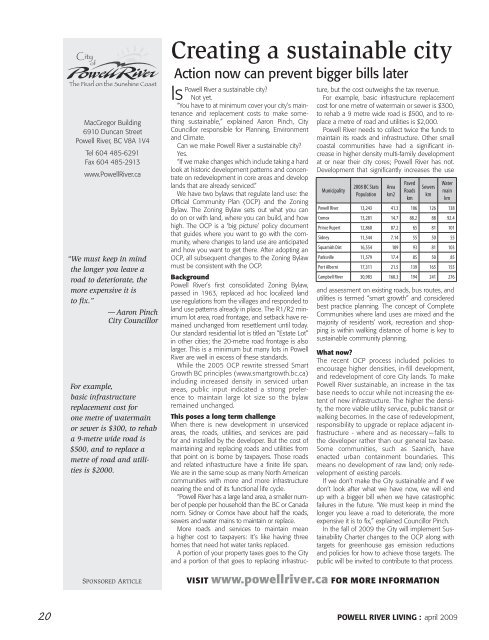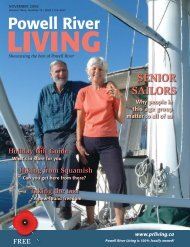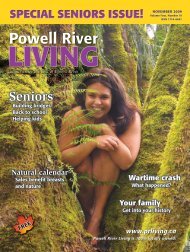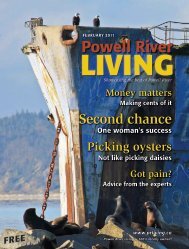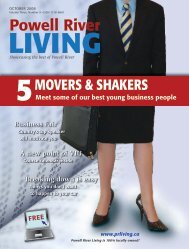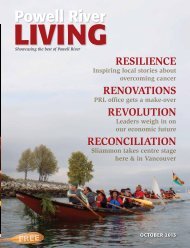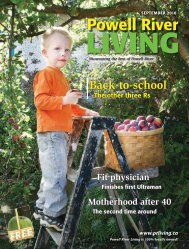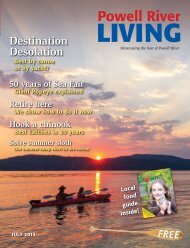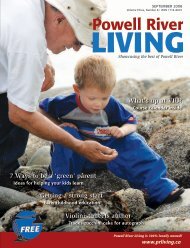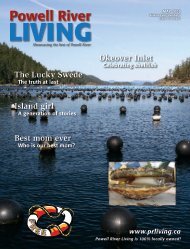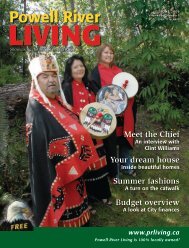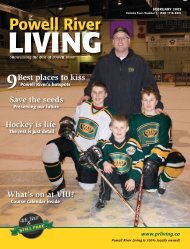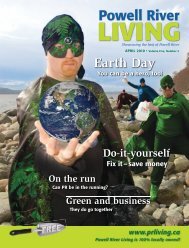Stunning Go for the green Real estate tips Healthy point of VIU
op for... - Powell River Living
op for... - Powell River Living
- No tags were found...
You also want an ePaper? Increase the reach of your titles
YUMPU automatically turns print PDFs into web optimized ePapers that Google loves.
MacGregor Building<br />
6910 Duncan Street<br />
Powell River, BC V8A 1V4<br />
Tel 604 485-6291<br />
Fax 604 485-2913<br />
www.PowellRiver.ca<br />
“We must keep in mind<br />
<strong>the</strong> longer you leave a<br />
road to deteriorate, <strong>the</strong><br />
more expensive it is<br />
to fix.”<br />
— Aaron Pinch<br />
City Councillor<br />
For example,<br />
basic infrastructure<br />
replacement cost <strong>for</strong><br />
one metre <strong>of</strong> watermain<br />
or sewer is $300, to rehab<br />
a 9-metre wide road is<br />
$500, and to replace a<br />
metre <strong>of</strong> road and utilities<br />
is $2000.<br />
SPONSORED ARTICLE<br />
Creating a sustainable city<br />
Action now can prevent bigger bills later<br />
Powell River a sustainable city?<br />
Is Not yet.<br />
“You have to at minimum cover your city’s maintenance<br />
and replacement costs to make something<br />
sustainable,” explained Aaron Pinch, City<br />
Councillor responsible <strong>for</strong> Planning, Environment<br />
and Climate.<br />
Can we make Powell River a sustainable city?<br />
Yes.<br />
“If we make changes which include taking a hard<br />
look at historic development patterns and concentrate<br />
on redevelopment in core areas and develop<br />
lands that are already serviced.”<br />
We have two bylaws that regulate land use: <strong>the</strong><br />
Official Community Plan (OCP) and <strong>the</strong> Zoning<br />
Bylaw. The Zoning Bylaw sets out what you can<br />
do on or with land, where you can build, and how<br />
high. The OCP is a ‘big picture’ policy document<br />
that guides where you want to go with <strong>the</strong> community,<br />
where changes to land use are anticipated<br />
and how you want to get <strong>the</strong>re. After adopting an<br />
OCP, all subsequent changes to <strong>the</strong> Zoning Bylaw<br />
must be consistent with <strong>the</strong> OCP.<br />
Background<br />
Powell River’s first consolidated Zoning Bylaw,<br />
passed in 1963, replaced ad hoc localized land<br />
use regulations from <strong>the</strong> villages and responded to<br />
land use patterns already in place. The R1/R2 minimum<br />
lot area, road frontage, and setback have remained<br />
unchanged from resettlement until today.<br />
Our standard residential lot is titled an “Estate Lot”<br />
in o<strong>the</strong>r cities; <strong>the</strong> 20-metre road frontage is also<br />
larger. This is a minimum but many lots in Powell<br />
River are well in excess <strong>of</strong> <strong>the</strong>se standards.<br />
While <strong>the</strong> 2005 OCP rewrite stressed Smart<br />
Growth BC principles (www.smartgrowth.bc.ca)<br />
including increased density in serviced urban<br />
areas, public input indicated a strong preference<br />
to maintain large lot size so <strong>the</strong> bylaw<br />
remained unchanged.<br />
This poses a long term challenge<br />
When <strong>the</strong>re is new development in unserviced<br />
areas, <strong>the</strong> roads, utilities, and services are paid<br />
<strong>for</strong> and installed by <strong>the</strong> developer. But <strong>the</strong> cost <strong>of</strong><br />
maintaining and replacing roads and utilities from<br />
that <strong>point</strong> on is borne by taxpayers. Those roads<br />
and related infrastructure have a finite life span.<br />
We are in <strong>the</strong> same soup as many North American<br />
communities with more and more infrastructure<br />
nearing <strong>the</strong> end <strong>of</strong> its functional life cycle.<br />
“Powell River has a large land area, a smaller number<br />
<strong>of</strong> people per household than <strong>the</strong> BC or Canada<br />
norm. Sidney or Comox have about half <strong>the</strong> roads,<br />
sewers and water mains to maintain or replace.<br />
More roads and services to maintain mean<br />
a higher cost to taxpayers: It’s like having three<br />
homes that need hot water tanks replaced.<br />
A portion <strong>of</strong> your property taxes goes to <strong>the</strong> City<br />
and a portion <strong>of</strong> that goes to replacing infrastructure,<br />
but <strong>the</strong> cost outweighs <strong>the</strong> tax revenue.<br />
For example, basic infrastructure replacement<br />
cost <strong>for</strong> one metre <strong>of</strong> watermain or sewer is $300,<br />
to rehab a 9 metre wide road is $500, and to replace<br />
a metre <strong>of</strong> road and utilities is $2,000.<br />
Powell River needs to collect twice <strong>the</strong> funds to<br />
maintain its roads and infrastructure. O<strong>the</strong>r small<br />
coastal communities have had a significant increase<br />
in higher density multi-family development<br />
at or near <strong>the</strong>ir city cores; Powell River has not.<br />
Development that significantly increases <strong>the</strong> use<br />
Municipality<br />
2008 BC Stats<br />
Population<br />
and assessment on existing roads, bus routes, and<br />
utilities is termed “smart growth” and considered<br />
best practice planning. The concept <strong>of</strong> Complete<br />
Communities where land uses are mixed and <strong>the</strong><br />
majority <strong>of</strong> residents’ work, recreation and shopping<br />
is within walking distance <strong>of</strong> home is key to<br />
sustainable community planning.<br />
What now?<br />
The recent OCP process included policies to<br />
encourage higher densities, in-fill development,<br />
and redevelopment <strong>of</strong> core City lands. To make<br />
Powell River sustainable, an increase in <strong>the</strong> tax<br />
base needs to occur while not increasing <strong>the</strong> extent<br />
<strong>of</strong> new infrastructure. The higher <strong>the</strong> density,<br />
<strong>the</strong> more viable utility service, public transit or<br />
walking becomes. In <strong>the</strong> case <strong>of</strong> redevelopment,<br />
responsibility to upgrade or replace adjacent infrastructure<br />
- where and as necessary — falls to<br />
<strong>the</strong> developer ra<strong>the</strong>r than our general tax base.<br />
Some communities, such as Saanich, have<br />
enacted urban containment boundaries. This<br />
means no development <strong>of</strong> raw land; only redevelopment<br />
<strong>of</strong> existing parcels.<br />
If we don’t make <strong>the</strong> City sustainable and if we<br />
don’t look after what we have now, we will end<br />
up with a bigger bill when we have catastrophic<br />
failures in <strong>the</strong> future. “We must keep in mind <strong>the</strong><br />
longer you leave a road to deteriorate, <strong>the</strong> more<br />
expensive it is to fix,” explained Councillor Pinch.<br />
In <strong>the</strong> fall <strong>of</strong> 2009 <strong>the</strong> City will implement Sustainability<br />
Charter changes to <strong>the</strong> OCP along with<br />
targets <strong>for</strong> <strong>green</strong>house gas emission reductions<br />
and policies <strong>for</strong> how to achieve those targets. The<br />
public will be invited to contribute to that process.<br />
VISIT www.powellriver.ca FOR MORE INFORMATION<br />
Area<br />
km2<br />
Paved<br />
Roads<br />
km<br />
Sewers<br />
km<br />
Water<br />
main<br />
km<br />
Powell River 13,243 41.3 106 126 138<br />
Comox 13,281 14.7 88.2 88 92.4<br />
Prince Rupert 12,860 87.2 65 81 101<br />
Sidney 11,544 7.14 55 50 55<br />
Squamish Dist 16,554 109 93 81 103<br />
Parksville 11,579 17.4 85 50 85<br />
Port Alberni 17,311 21.5 139 165 155<br />
Campbell River 30,983 160.3 194 241 276<br />
20 Powell River Living : april 2009


